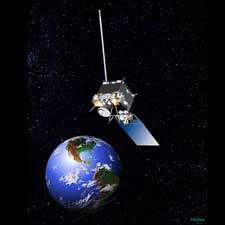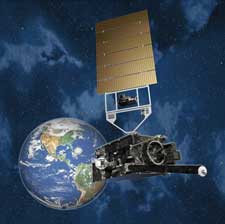Earth's weather happens inside the Sun's weather!
Our “How's the weather on other planets?” page takes you on a tour of the nasty weather on other planets and moons in the solar system. Thank goodness we have only Earth's weather to worry about, right?
Wrong!
Weather Within Weather
Our star—the Sun—is a bubbling, boiling ball of fire. See Picture 1 to the right. It constantly belches out great clouds of hot gas. This gas is all charged up with electricity, too. This stuff travels at astounding speeds, some of it right toward Earth! This means that Earth’s weather happens inside the Sun’s weather!
Thank goodness Earth’s magnetic field (see Picture 2) and atmosphere protect us from most of this blast. Otherwise, the Sun’s weather would be OUR weather. Yikes!
However, we are still affected by the Sun’s atmosphere and its violent activities. We call this part of our weather “space weather,” because it comes to us through space from the Sun.
Faster Than a Hurricane!
Solar wind blows at about 600,000 to 2,000,000 miles per hour. That’s two million miles per hour! The solar wind flows around obstacles, such as planets and moons. However, if a planet has a magnetic field, as Earth does, the charged particles flow around the magnetic field. The solar wind pushes on the magnetic field, flattening it on the side facing the Sun, and pushing it out into a long tail on the opposite side. See the Picture 3 video.
You can’t see Earth’s magnetic lines of force. But if you have ever used a compass to find which way is north, you have seen one effect of these lines of force. The compass needle lines up right alongside the lines of force, which come out of the Earth’s magnetic South Pole and enter Earth’s magnetic North Pole. See Picture 4.
Where Space Weather is Beautiful
The solar wind follows the magnetic lines of force. Some of the charged particles flow right down into Earth’s atmosphere near the Poles. When these charged particles hit Earth’s atmosphere, they glow in beautiful shades of green and red. Notice the glow near the Poles in the Picture 3 video.
We call these glowing colors the Northern Lights and Southern Lights, or the Aurora Borealis and Aurora Australis. They are beautiful curtains of light that move and sway in the night sky. Usually, you can see them only if you live somewhat close to the North or South Pole, far from the equator. See Pictures 5 and 6.
Sometimes you can see the auroras far from the North or South Poles. Picture 7 is a map that shows how likely you are on a certain day to see the Northern Lights from any location in the Northern Hemisphere. Areas colored yellow are more likely to see it than areas colored blue. Sometimes the map looks very different, with the yellow area much larger.
Here It Comes!
But sometimes the Sun gets extra restless. It has “solar indigestion!” These sudden and intense hiccups and burps are called solar flares and coronal mass ejections (CMEs). The effects of these types of space weather are not so pretty! As a matter of fact, they can be very bad for humans and their equipment.
A solar flare happens when the Sun suddenly burps out a blast of extra energy. Some of this energy is very “high-energy” energy called X-rays. CMEs are even bigger burps. CMEs are the biggest explosions in the solar system. See Picture 8.
When all these X-rays and charged particles reach Earth, they cause trouble.
Quick, Where Can We Hide?
"Bad space weather" can interrupt radio signals. It can damage satellites. Ships at sea might not be able to use navigation equipment that relies on satellites. Also, their two-way radios might not work. They could get lost or run aground in shallow water.
Electrical systems that bring power to our homes and business can be knocked out by this “bad space weather” too.
And what about the astronauts living in the International Space Station or on a Space Shuttle mission? The Space Station and Shuttle have radiation shielding built in. But the astronauts certainly would not go out “space walking” during bad space weather. The extra radiation could make them sick.
Even airplane crew members can be affected if they often fly over the North Pole. More radiation from space weather events comes down into the atmosphere near the Poles.
If Only We Had Some Warning!
Just as we need early warnings about hurricanes, tornadoes, and other bad weather, having early warnings of bad space weather helps keep damage to a minimum.
That is why the GOES (short for Geostationary Operational Environmental Satellite) has a Solar X-ray Imager and other instruments to measure the space environment. These special telescopes can detect X-rays (which our eyes cannot). (See Picture 9 for a video.) Every minute they take a picture of the Sun using X-rays. They give space weather forecasters information that helps them to warn others of solar events that could harm satellites and systems on the ground.
The main job of GOES is to watch what the weather is up to on Earth.
Another type of satellite that monitors space weather is the POES (short for Polar-orbiting Operational environmental Satellite). The POES keep an eye on Earth's climate, but also monitor the energy entering Earth's atmosphere by charged particles from the Sun. Picture 7 is an example of what can be done with this POES data.






